Intel Developer Forum 2016: The 10 Biggest Technology Announcements

New Chips, IoT Applications, And More
Partners got a taste of the newest technology at this week's Intel Developer Forum in San Francisco – including new desktop processors from both Intel and its rivals, new Internet of Things products, and new Xeon chips for artificial intelligence systems.
Overall, IoT made up the majority of the show, with CEO Brian Krzanich stressing the opportunities around connected devices.
"The future starts with the Internet of Things… the boundary between digital and physical is eroding toward a world where computing is truly mobile. If you start to count the number of computers in your life today, it is constantly increasing and everything is truly smart and connected," said Krzanich during a keynote.
Beyond the Internet of Things, however, there were a number of other product announcements that will make partners applaud. Following are the 10 biggest announcements.
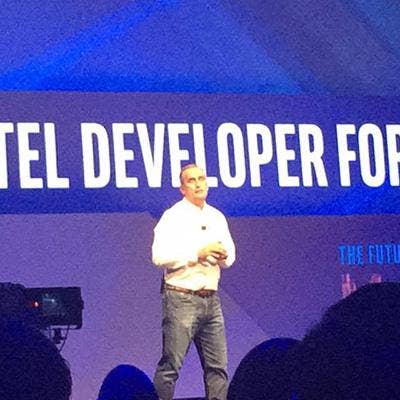
Kaby Lake
While little was said about desktop processors during the show, Intel CEO Brian Krzanich gave a preview of its seventh-generation Core chip, Kaby Lake, during his keynote Tuesday.
According to Krzanich, who demonstrated on stage the processor's power on an HP two-in-one laptop to edit 4K video, this successor to Intel's Skylake processor will be available on Intel OEM partners' systems in the fall and will have powerful graphics capabilities for the enthusiast segment and gaming. He said that this hardware supports the HEVC Main10 profile, which means it can play 4K premium content "without a hitch."
Kaby Lake will also feature support for Thunderbolt 3, native USB 3.1, and DisplayPort 1.2.
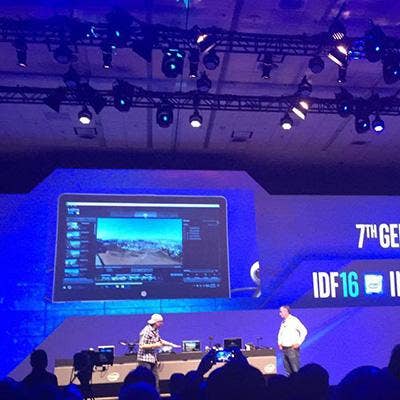
Joule Module
Intel on Tuesday introduced the Joule platform, a module built for IoT applications that packs a high-performance system-on-module into a low-power package. This Intel Maker Board enables users to build a concept into a prototype and then to production at a "fraction of the time and development cost," according to Intel.
According to intel, Joule features high-end compute, 4K video and large-memory capabilities, as well as support for RealSense technology and other Intel software tools.
Joule is available in two models – 550x and the higher-performance 570x – and the developer kit will begin shipping in September through Intel reseller partners.
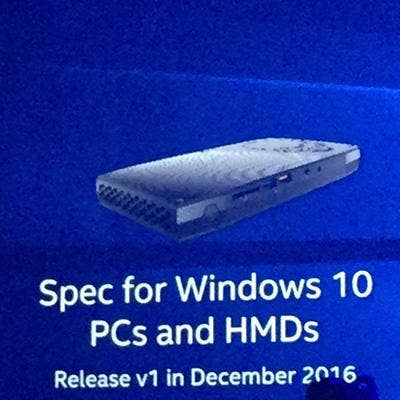
Knowledge Builder Toolkit
Intel's other foray into the Internet of Things was through a new builder kit that Krzanich introduced during his keynote Tuesday.
This Knowledge Builder Toolkit enables developers to create intelligent sensing applications that run directly on Intel's low-power Curie module solution for wearables. The toolkit will be available in the first quarter of 2017, according to Intel.
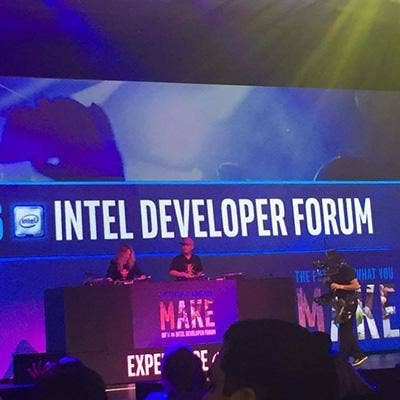
Xeon Phi
Intel paved out a strategy for a bigger play in artificial intelligence with its announcement Wednesday that its newest version of the Xeon Phi processor will have added features around AI.
Xeon Phi processors, now used in data centers and in advanced deep-learning applications, will be able to accelerate tasks and software associated with artificial intelligence – helping machines interpret speech and pilot autonomous vehicles.
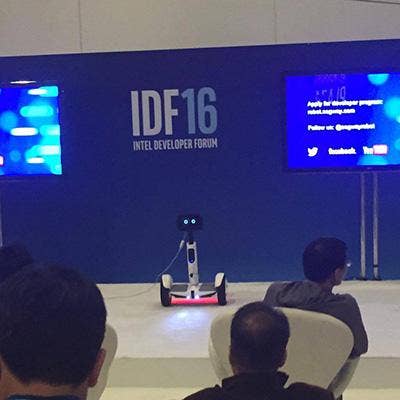
Project Alloy
Intel unveiled Project Alloy, the company's wireless virtual reality headset that leverages its RealSense 3D camera technology, which will be part of Windows Holographic, so Windows 10 PC users can utilize head mounted displays to interact with 3D applications.
Intel outlined similar strategies for virtual reality that combines virtual reality and augmented reality into a single cohesive device, a concept that Intel has coined "merged reality."
The headset is completely wireless, can track the user's hands for interacting with virtual reality, and – unlike other headsets like Oculus Rift and HTC Vive – doesn't rely on a PC for processing power.

Microsoft And Intel Link Up To Bring VR To Windows 10 PCs
Intel said Tuesday is it linking up with Microsoft to bring a virtual reality platform, Windows Holographic, to Windows 10 PCs as the two companies work together to dominate the VR space.
The Holographic platform will be available to all Windows 10 PCs next year, according to Microsoft – and Intel's Alloy hardware specifications will be open sourced for developers at an undisclosed time in the future.
Microsoft Windows Chief Terry Myerson, who came on stage during Krzanich's keynote, said that PCs will work with a head-mounted display and run Holographic applications – so PC users can interact with 3D applications.

Silicon Photonics "Available in Volume"
Intel's data center executive Diane Bryant announced Wednesday that the company is beginning volume shipments of its Silicon Photonics networking technology – which, she said, have been 16 years in the making.
These optical-networking components use light through thin glass fiber, as opposed to copper wires, to create high-speed systems for data centers. The product, which Intel said delivers 100 gigabits per second, uses silicon lithography to automatically align the laser – making it a cost-effective alternative to fiber optics.

Intel To Make ARM-Based Chips For Smartphones
Intel announced on Tuesday that one of its factories will start producing ARM chips for use in smartphones. The new licensing agreement, which will be for Intel chips developed through the 10nm foundry node, includes deals to produce chips for LG, Netronome, and Spreadrum.
The deal comes after Intel shut down its mobile Atom projects – SoFIA and Broxton - a few months ago. It positions Intel to take another stab at the mobile market as ARM-based chips are powering the majority of the world's mobile phones today.

AMD Zen
Other competing chip manufacturers often like to crash Intel Developer Forum by releasing their own products. AMD did just that Thursday by unveiling its Zen CPU.
This CPU, which AMD says will outperform Intel's Broadwell-E, has been delayed until early 2017 and will be produced on the 14nm manufacturing process. Zen ditches some of the architectural mistakes the company made in earlier CPU cores, such as clustered multithreading. The chip will also have a new cache memory hierarchy with 8MB of L3 cache and will tout a 40-percent increase in instructions-per-clock performance over its Excavator core. The company did not discuss Zen's target clock speed.
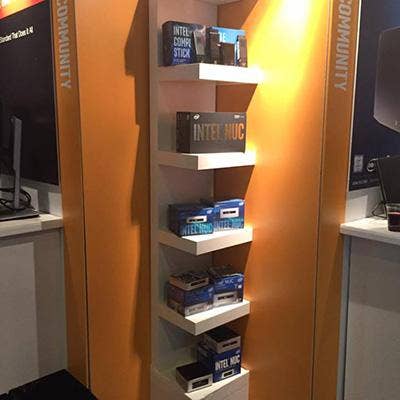
AeroReady
Intel showcased its Aero platform for unmanned aerial vehicles, called Aero Ready, on Tuesday. This quadcopter features a compute board, integrated depth and vision capabilities using Intel's RealSense depth perception technology — which the company says is the fastest path available from Intel for developers to get applications airborne.
The Aero Ready To Fly Drone supports several "plug and play" options, including a flight controller with Dronecode PX4 software, Intel RealSense for vision and AirMap SDK for airspace services. The Aero compute board is available for $399 and the AeroReady platform will be available by the end of the year.